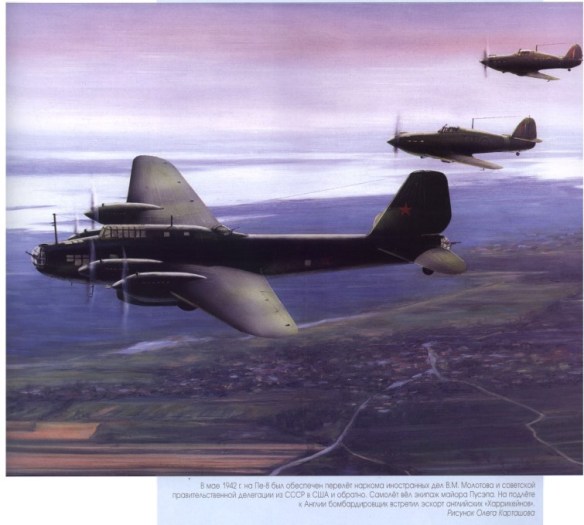In April 1942 a crew captained by Major Asyanov accomplished a non-stop flight to Great Britain in a Pe-8 bomber, carrying embassy officials and diplomatic mail. This flight presaged another, to the USA and back via England, on 19th May 1942. On board for this trip were the Soviet Minister of Foreign Affairs, Vyacheslav Molotov, and his staff. In spite of great difficulties the flight was successful, and the aircraft’s commanding officer and navigators Major Romanov and Major Shtepenko were made Heroes of the Soviet Union.
Petlyakov Pe-8
The Petlyakov Pe-8 was the Soviet Union’s only modern four-engine bomber of World War II, the original design concept being outlined by A. N. Tupolev to meet a mid-1934 requirement for an aircraft of this class. A cantilever mid-wing monoplane of all-metal construction, except for fabric-covered control surfaces, the ANT-42 as it was then known had retractable tailwheel landing gear with only the main units retracting. Planned powerplant was four wing¬-mounted engines with a central supercharger installation in the fuselage, but when first flown on 27 December 1936 the ATsN supercharger installation was not available and the ANT-42 was powered by four 820-kW (1,100-hp) Mikulin M-100 Vee engines. Although the aircraft was damaged subsequently in a heavy landing, official testing was completed during 1937, following which the ATsN supercharger, driven by a single M-100 engine, became available. The second prototype ANT-42 was flown on 26 July 1938, this having many improvements including an ATsN-2 supercharger driven by an M-100A engine. There was accommodation for a of 11 and the aircraft had full armament comprising electrically-actuated dorsal and tail turrets, each with a 7.62-mm (0.3-in) ShKAS machine-gun; a nose turret with a single (later twin) ShKAS machine-gun, plus a position in the rear of each inboard engine nacelle, accessible to the gunner through a wing crawl-way, each provided with a single 12.7-mm (0.5-in) machine-gun. Standard bomb-load was six 100-kg (220-Ib) or four 250-kg (551-Ib) bombs, but over suitable short ranges a maximum overload of 4000 kg (8,818 lb) of bombs could be carried.
The manufacture of five pre-production aircraft was authorised in April 1937, but there was a subsequent attempt to end the programme. However, production was finally approved in 1939 under the designation TB-7 and these five pre-¬series aircraft differed from the ANT-42 by having the ATsN central supercharger installation deleted and the main engines replaced by supercharged AM-35s. At the same time several airframe improvements were introduced and deliveries of these pre-production aircraft began in May 1940. Performance with the AM-35 powerplant was disappointing, leading to the evaluation of several different engines, but in October 1940 the 1044-kW (1,400-hp) ACh-40 diesel was selected as standard powerplant. This proved unreliable, bringing continued use of the 1007-kW (1,350-hp) AM-35A. until those in service were re-engined with the 1119-kW (1,500-hp) ACh-30B diesel. On the night of 7/8 August 194118 of these aircraft made an attack on Berlin, but with one crashing on take-off from engine failure and eight others making forced landings for the same reason, it was finally decided to discontinue the use of diesel engines. By that time the designation TB-7 had been dropped in favour of Pe-8, and when production ended in October 1941 a total of 79 had been built; by the end of 1942 about 48 of this total had been re-engined with the ASh-82FN. One aircraft with AM-35A engines made a remarkable staged flight from Moscow to Washington and back during the period 19 May to 13 June 1942.
Surviving aircraft were used extensively during 1942-43 for close-support bombing and, from February 1943, were used to deploy the FAB-5000NG 5000-kg (11,023-Ib) bomb for point attacks on special targets.
Post-war about 30 Pe-8s survived and were used for a variety of purposes, including employment as engine testbeds, and in 1952 two of them played a key role in establishing an Arctic station before returning the expedition to Moscow in a non-stop flight of 5000 km (3,107 miles).
